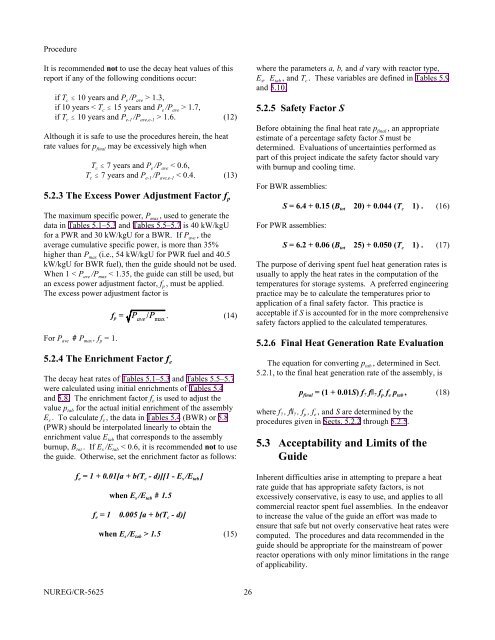NUREG/CR-5625 (ORNL-6698) - Oak Ridge National Laboratory
NUREG/CR-5625 (ORNL-6698) - Oak Ridge National Laboratory
NUREG/CR-5625 (ORNL-6698) - Oak Ridge National Laboratory
You also want an ePaper? Increase the reach of your titles
YUMPU automatically turns print PDFs into web optimized ePapers that Google loves.
Procedure<br />
It is recommended not to use the decay heat values of this<br />
report if any of the following conditions occur:<br />
if T c # 10 years and P e /P ave > 1.3,<br />
if 10 years < T c # 15 years and P e /P ave > 1.7,<br />
if T c # 10 years and P e-1 /P ave,e-1 > 1.6. (12)<br />
Although it is safe to use the procedures herein, the heat<br />
rate values for p may be excessively high when<br />
final<br />
T # 7 years and P /P < 0.6,<br />
c e ave<br />
T # 7 years and P /P < 0.4. (13)<br />
c e-1 ave,e-1<br />
5.2.3 The Excess Power Adjustment Factor f p<br />
The maximum specific power, P max , used to generate the<br />
data in Tables 5.1–5.3 and Tables 5.5–5.7 is 40 kW/kgU<br />
for a PWR and 30 kW/kgU for a BWR. If P ave , the<br />
average cumulative specific power, is more than 35%<br />
higher than P max (i.e., 54 kW/kgU for PWR fuel and 40.5<br />
kW/kgU for BWR fuel), then the guide should not be used.<br />
When 1 < P ave /P max < 1.35, the guide can still be used, but<br />
an excess power adjustment factor, f , must be applied.<br />
p<br />
The excess power adjustment factor is<br />
For P # P , f = 1.<br />
ave max p<br />
5.2.4 The Enrichment Factor f e<br />
f = P ave<br />
/P max<br />
.<br />
(14)<br />
p<br />
The decay heat rates of Tables 5.1–5.3 and Tables 5.5–5.7<br />
were calculated using initial enrichments of Tables 5.4<br />
and 5.8. The enrichment factor f is used to adjust the<br />
e<br />
value p for the actual initial enrichment of the assembly<br />
tab<br />
E s . To calculate f e , the data in Tables 5.4 (BWR) or 5.8<br />
(PWR) should be interpolated linearly to obtain the<br />
enrichment value E that corresponds to the assembly<br />
tab<br />
burnup, B . If E /E < 0.6, it is recommended not to use<br />
tot s tab<br />
the guide. Otherwise, set the enrichment factor as follows:<br />
f = 1 + 0.01[a + b(T - d)][1 - E /E ]<br />
e c s tab<br />
when E s /E tab # 1.5<br />
f e = 1 – 0.005 [a + b(T c - d)]<br />
when E s /E tab > 1.5 (15)<br />
where the parameters a, b, and d vary with reactor type,<br />
E s, E tab , and T c . These variables are defined in Tables 5.9<br />
and 5.10.<br />
5.2.5 Safety Factor S<br />
Before obtaining the final heat rate p final , an appropriate<br />
estimate of a percentage safety factor S must be<br />
determined. Evaluations of uncertainties performed as<br />
part of this project indicate the safety factor should vary<br />
with burnup and cooling time.<br />
For BWR assemblies:<br />
S = 6.4 + 0.15 (B tot – 20) + 0.044 (T c – 1) . (16)<br />
For PWR assemblies:<br />
S = 6.2 + 0.06 (B tot – 25) + 0.050 (T c – 1) . (17)<br />
The purpose of deriving spent fuel heat generation rates is<br />
usually to apply the heat rates in the computation of the<br />
temperatures for storage systems. A preferred engineering<br />
practice may be to calculate the temperatures prior to<br />
application of a final safety factor. This practice is<br />
acceptable if S is accounted for in the more comprehensive<br />
safety factors applied to the calculated temperatures.<br />
5.2.6 Final Heat Generation Rate Evaluation<br />
The equation for converting p tab , determined in Sect.<br />
5.2.1, to the final heat generation rate of the assembly, is<br />
p = (1 + 0.01S) f fN f f p , (18)<br />
final 7 7 p e tab<br />
where f , fN , f , f , and S are determined by the<br />
7 7 p e<br />
procedures given in Sects. 5.2.2 through 5.2.5.<br />
5.3 Acceptability and Limits of the<br />
Guide<br />
Inherent difficulties arise in attempting to prepare a heat<br />
rate guide that has appropriate safety factors, is not<br />
excessively conservative, is easy to use, and applies to all<br />
commercial reactor spent fuel assemblies. In the endeavor<br />
to increase the value of the guide an effort was made to<br />
ensure that safe but not overly conservative heat rates were<br />
computed. The procedures and data recommended in the<br />
guide should be appropriate for the mainstream of power<br />
reactor operations with only minor limitations in the range<br />
of applicability.<br />
<strong>NUREG</strong>/<strong>CR</strong>-<strong>5625</strong> 26
















